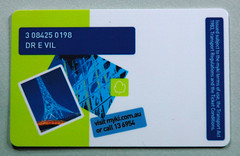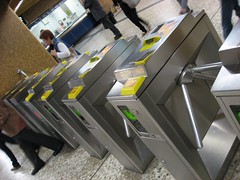 I was one of the early adopters of Myki for my public transport ticketing, and it wasn’t the best of experiences. I went back to using Metcard shortly afterwards, and it was only once Myki was fully deployed across trams and buses did I go back to it.
I was one of the early adopters of Myki for my public transport ticketing, and it wasn’t the best of experiences. I went back to using Metcard shortly afterwards, and it was only once Myki was fully deployed across trams and buses did I go back to it.
I’ve been using the Myki Money approach, which in theory is cheaper than the Myki Pass approach, but requires the user to “touch on” before travel and “touch off” afterwards. I’ve been using it for over six months now, but recently I’ve suspected that it hasn’t been operating quite as it should.
Although I’m well trained now in “touching off” at the train platform, I find it hard to remember to do it when jumping off a tram. In one instance, leaving a tram to catch a train, my Myki failed to be recognised at the train station turnstiles (no error message – nothing), probably due to the card thinking I’d only recently “touched on” to a tram, so how could I possibly be touching on to a train. How helpful. Not.
Failing to “touch off” on trams has also meant that I’ve been charged extra, as the system assumes I might have traveled into Zone 2, while in fact I’ve remained in Zone 1. This is as-designed, but is highly annoying. Given that I don’t catch trams often enough to reprogram my habit of leaving the tram without touching off, it’s probably sufficient to motivate me to stop using Myki Money.
However, there’s another problem I’m experiencing that’s not meant to happen: sometimes, I’m charged more than the official fare. If I travel more than two trips – more than a train to work and then a train home – it seems I get charged for those extra trips, even though Myki Money is not meant to cost more than a standard daily rate (which is equivalent to two trips). All it takes is to use the tram twice on a normal day to be overcharged by 100%.
Luckily, there’s a free online tool that can help spot these overcharges: Mykileaks. It takes your Myki transaction statement, analyses it, and provides you with clear advice on exactly where you’ve been overcharged. The process is:
- Log in to “My Myki” and download a PDF statement of “My transactions”. Set the filter options to include as much as the last six months, then press the “View and Print Statement” button.
- Visit Mykileaks, specify the file for the PDF statement, and press the “Submit your statement for analysis” button.
- Read the resulting report, and confirm that it makes sense.
- Go back to “My Myki” and open the Refund and Reimbursement Form. Fill it in, print and post to Myki.
Ok, so it’s a bit laborious, but it really irks me that they still run this system with overcharging bugs in it. Mykileaks found that I had a case for being overcharged $14.66 over the last five months. According to a Herald Sun article, around 300,000 people used Myki in March, which if my level of overcharges is typical, would equate to $10.5M in unjustified charges over the course of a year.
I’m going to send in my reimbursement claim, and once it’s used up, Myki Money can “sod off”.

![Reblog this post [with Zemanta]](http://img.zemanta.com/reblog_e.png?x-id=15bee8bd-9916-4d1e-8367-f36b1c57c6f6)
